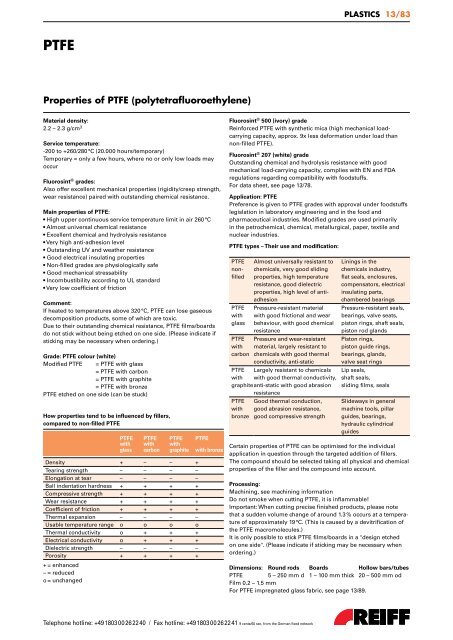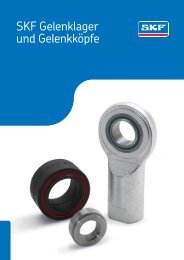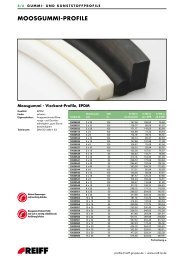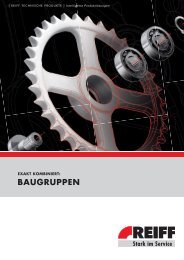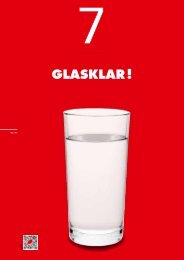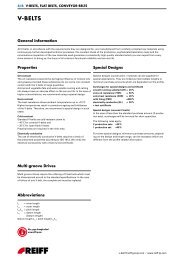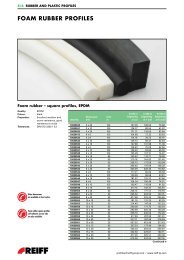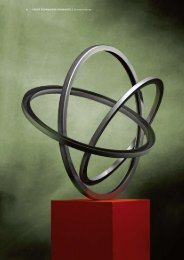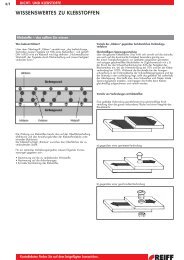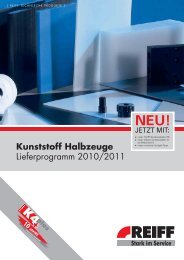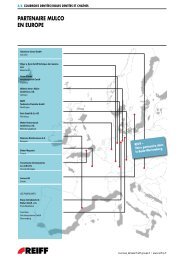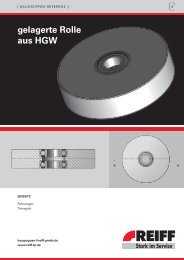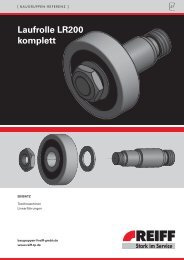REGISTER OVERVIEW PLASTICS
REGISTER OVERVIEW PLASTICS
REGISTER OVERVIEW PLASTICS
Create successful ePaper yourself
Turn your PDF publications into a flip-book with our unique Google optimized e-Paper software.
PTFE<br />
Properties of PTFE (polytetrafluoroethylene)<br />
Material density:<br />
2.2 – 2.3 g/cm 3<br />
Service temperature:<br />
-200 to +260/280 °C (20.000 hours/temporary)<br />
Temporary = only a few hours, where no or only low loads may<br />
occur<br />
Fluorosint ® grades:<br />
Also offer excellent mechanical properties (rigidity/creep strength,<br />
wear resistance) paired with outstanding chemical resistance.<br />
Main properties of PTFE:<br />
• High upper continuous service temperature limit in air 260 °C<br />
• Almost universal chemical resistance<br />
• Excellent chemical and hydrolysis resistance<br />
• Very high anti-adhesion level<br />
• Outstanding UV and weather resistance<br />
• Good electrical insulating properties<br />
• Non-filled grades are physiologically safe<br />
• Good mechanical stressability<br />
• Incombustibility according to UL standard<br />
• Very low coefficient of friction<br />
Comment:<br />
If heated to temperatures above 320 °C, PTFE can lose gaseous<br />
decomposition products, some of which are toxic.<br />
Due to their outstanding chemical resistance, PTFE films/boards<br />
do not stick without being etched on one side. (Please indicate if<br />
sticking may be necessary when ordering.)<br />
Grade: PTFE colour (white)<br />
Modified PTFE = PTFE with glass<br />
= PTFE with carbon<br />
= PTFE with graphite<br />
= PTFE with bronze<br />
PTFE etched on one side (can be stuck)<br />
How properties tend to be influenced by fillers,<br />
compared to non-filled PTFE<br />
+ = enhanced<br />
– = reduced<br />
o = unchanged<br />
PTFE PTFE PTFE PTFE<br />
with<br />
glass<br />
with<br />
carbon<br />
with<br />
graphite with bronze<br />
Density + – – +<br />
Tearing strength – – – –<br />
Elongation at tear – – – –<br />
Ball indentation hardness + + + +<br />
Compressive strength + + + +<br />
Wear resistance + + + +<br />
Coefficient of friction + + + +<br />
Thermal expansion – – – –<br />
Usable temperature range o o o o<br />
Thermal conductivity o + + +<br />
Electrical conductivity o + + +<br />
Dielectric strength – – – –<br />
Porosity + + + +<br />
Telephone hotline: +49 1803 00 26 22 40 / Fax hotline: +49 1803 00 26 22 41 9 cents/60 sec. from the German fixed network<br />
<strong>PLASTICS</strong> 13/83<br />
Fluorosint ® 500 (ivory) grade<br />
Reinforced PTFE with synthetic mica (high mechanical loadcarrying<br />
capacity, approx. 9x less deformation under load than<br />
non-filled PTFE).<br />
Fluorosint ® 207 (white) grade<br />
Outstanding chemical and hydrolysis resistance with good<br />
mechanical load-carrying capacity, complies with EN and FDA<br />
regulations regarding compatibility with foodstuffs.<br />
For data sheet, see page 13/78.<br />
Application: PTFE<br />
Preference is given to PTFE grades with approval under foodstuffs<br />
legislation in laboratory engineering and in the food and<br />
pharmaceutical industries. Modified grades are used primarily<br />
in the petrochemical, chemical, metallurgical, paper, textile and<br />
nuclear industries.<br />
PTFE types – Their use and modification:<br />
PTFE<br />
nonfilled<br />
PTFE<br />
with<br />
glass<br />
PTFE<br />
with<br />
carbon<br />
Almost universally resistant to<br />
chemicals, very good sliding<br />
properties, high temperature<br />
resistance, good dielectric<br />
properties, high level of antiadhesion<br />
Pressure-resistant material<br />
with good frictional and wear<br />
behaviour, with good chemical<br />
resistance<br />
Pressure and wear-resistant<br />
material, largely resistant to<br />
chemicals with good thermal<br />
conductivity, anti-static<br />
PTFE Largely resistant to chemicals<br />
with with good thermal conductivity,<br />
graphiteanti-static<br />
with good abrasion<br />
resistance<br />
PTFE Good thermal conduction,<br />
with good abrasion resistance,<br />
bronze good compressive strength<br />
Linings in the<br />
chemicals industry,<br />
flat seals, enclosures,<br />
compensators, electrical<br />
insulating parts,<br />
chambered bearings<br />
Pressure-resistant seals,<br />
bearings, valve seats,<br />
piston rings, shaft seals,<br />
piston rod glands<br />
Piston rings,<br />
piston guide rings,<br />
bearings, glands,<br />
valve seat rings<br />
Lip seals,<br />
shaft seals,<br />
sliding films, seals<br />
Slideways in general<br />
machine tools, pillar<br />
guides, bearings,<br />
hydraulic cylindrical<br />
guides<br />
Certain properties of PTFE can be optimised for the individual<br />
application in question through the targeted addition of fillers.<br />
The compound should be selected taking all physical and chemical<br />
properties of the filler and the compound into account.<br />
Processing:<br />
Machining, see machining information<br />
Do not smoke when cutting PTFE, it is inflammable!<br />
Important: When cutting precise finished products, please note<br />
that a sudden volume change of around 1.3 % occurs at a temperature<br />
of approximately 19 °C. (This is caused by a devitrification of<br />
the PTFE macromolecules.)<br />
It is only possible to stick PTFE films/boards in a "design etched<br />
on one side". (Please indicate if sticking may be necessary when<br />
ordering.)<br />
Dimensions: Round rods Boards Hollow bars/tubes<br />
PTFE 5 – 250 mm d 1 – 100 mm thick 20 – 500 mm od<br />
Film 0.2 – 1.5 mm<br />
For PTFE impregnated glass fabric, see page 13/89.


